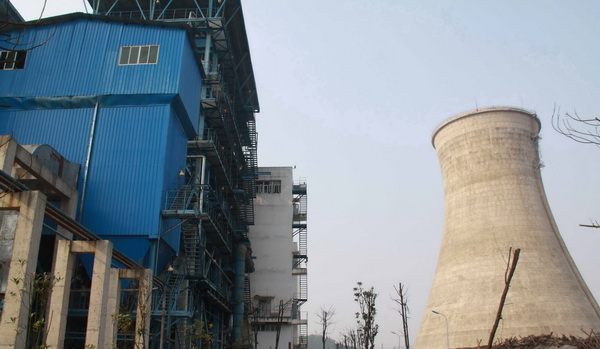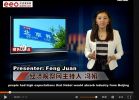

Highlights from the EO print edition, No. 627, July 8, 2013

Amendments to Environmental Protection Law Overhauled
News, page 5
~ The process of having the the Standing Committee of the National People's Congress deliberate on the second draft of amendments to China's Environment Protection Law began in late June.
~ Disputes have been ongoing since the decision to first amend the law was made in January, 2011. In September 2011, based on the first draft made by the Ministry of Environmental Protection and the proposals of scholars, the Environment and Resource Protection Commission of the NPC completed the first draft of the amendments. After several revisions were made, the draft amendment passed a first reading by the Standing Committee of the NPC in August 2012. Following a process of publc consultation, many significant changes have been made to the amendments.
~ Nearly all of the Legislative Affairs Commission and Law Committee of the NPC who worked on the second draft agreed that the law should be comprehensive and aim to solve a series of common problems. They also agreed on a few guiding principles, such as, protection is the top priority, public participation should be encouraged and polluters should shoulder responsibility for their actions.
~ One change to the draft amendments is in relation to the role of local governments in enforcing environmental laws. In the past, many local governments pursued GDP growth at the expense of the environment. In this latest draft it's clearly stipulated that "local governments at all levels should be responsible for the pollution and environmental problems in their own administrative regions." Irresponsible local leaders who fail to enforce environmental laws may be marked down, demoted or even removed from their post.
~ A section outlining how environmental protection information should be made available to the public was also added to the amendments. This section covers data such as environment monitoring, sudden environmental incidents, the issuance of licenses, pollution charges and certain environmental indicators.
~ In addition greater emphasis has also been placed on garnering popular opinion and encouraging public participation in the environmental evaluation process of major construction projects. These amendments have been added as a direct response to the frequent outbreaks of "mass incidents" or protests in recent years that are said to have been caused by a lack of "public supervision" over decision making and a failure to share information.
~ These draft amendments also differ from earlier ones in that heavy polluters will face severe punishments, especially in rural areas.
~ The committee members who worked on the draft amendments also said that the list of agencies that were qualified to launch legal proceedings against polluters needed to be diversified. Currently the number of agencies that can launch legal action is limited and also includes the All-China Environment Federation (中华环保联合会), which reportedly accepts financial support from polluting enterprises.
~ "Implementation is the most important thing for these amendments to the law," which is likely to be read a third time before it is passed, said Wang Xi (王曦), an environmental law expert at Shanghai's Jiaotong University (上海交通大学), "otherwise, it's all in vain."
Original article: [Chinese]

Contract Labor Regulations Under Review
News, page 4
~ From the beginning of this year the Ministry of Human Resources and Social Security (MOHRSS) has expedited the drafting and revision of Regulations on Labor Dispatching (劳务派遣条例) - a term used to refer the hiring of short-term or contract labor.
~ One of the proposed changes to the regulations is to alter the proportion of contract laborers that companies can employ. Currently the regulations state that companies should not hire more than 10 percent of the total number of employees through such outsourcing labor firms, which is consistent with the requirements included in the newly amended Labor Contract Law (劳动合同法) that came into effect on July 1, 2013. The All China Federation of Trade Unions (ACFTU) has proposed that this regulation should be lowered to 5 percent, while the State-owned Assets Supervision and Administration Commission (SASAC) argues for the rate to be increased to 15 percent.
~ A further highlight in the regulation is the principle of "equal pay for equal work" (同工同酬). According to research published by ACFTU, the majority of Chinese employers do not offer equivalent salaries and benefits to contractors and regular employees. Contractors not only receive lower wages but are also more vulnerable to being laid off.
~ The vice director of legal department of ACFTU Xie Liangming (谢良敏) told the EO that the regulation could alleviate the payment inequality.
~ In the past the ACFTU has expressed its concern about the large increase in the number workers that have signed labor contracts with intermediary employment agencies instead of directly with the enterprises for whom they actually work, which in many cases are state-owned enterprises. This outsourcing of the hiring process has meant that many workers do not benefit from the stronger protections that were awarded to them when the Labor Contract Law came into effect in 2008.
~ According to the earlier Labor Contract Law, employment companies can only sign contracts for workers engaged in temporary work. That means employers can avoid contributing to social security plans and can pay them less than workers who have signed contracts directly with their employers. According to what one person within the ACFTU told the EO, these employment practices were initially most prevalent in private, foreign and joint ventures, large-scale state-owned enterprises and a few other special sectors but have now already spread to all industries and sectors.
Original article: [Chinese]
China Shakes Up RMB "Currency Basket"
News, Page 6
~ Though there is no clear reform signal from the Central Bank, by comparing the exchange rates of how various currencies with the RMB and foreign exchange reserve data, it appears that China has been shaking up the weighting of the currencies that make up the "basket" it uses to help determine the value of the yuan.
~ As internationalization of RMB and the marketization of its exchange rate advance, variety and weights of different foreign currencies are in dire need of adjustment, said Tang Xinyu (汤新宇), an American-based financial analyst.
~ But the key issue for outsiders is that the weighting of each currency included in the basket is not disclosed. In 2011, Zhou Xiaochuan (周小川), the governor of China's central bank, listed twenty foreign currencies included in the basket but made no mentiong of their various weightings.
~ Tang Xinyu thinks that the weight of the U.S. dollars is diminishing while the weighting of the currencies of countries like Australia and Canada that export commodities to China is likely to have increased.
~ However, the real exchange rate of the RMB rose by 5.6 percent from January to May this year and it's safe to assume that the U.S. dollar still occupies a really large share of the currency basket.
Original article: [Chinese]

Chongqing Reborn: Recovering the City's Image After the Fall of Bo Xilai
Nation, page 14
~ Chongqing has been striving to restore its city image after the fall of Bo Xilai (薄熙来).
~ The PR department of the Chongqing Municipal Government recently launched an event called "Microbloggers in Chongqing (微博达人重庆行)", emphasizing Chongqing's city landscape and cuisine over political propaganda.
~ Apart from redefining Chongqing through social media, there have also been perceptible difference in the way the city government operates. Talking about the "Bo/Wang Incident" (薄王事件) is no longer considered taboo and officials are shying away from the media and preferring to present a low-key "getting down to business" approach.
~ Additionally, Chongqing government has put forward a series of measures to support privately-owned business in Chongqing.
Original article: [Chinese]
SMEs Financing Drought Intensifies
Market, page 18
~ The so-called "cash crunch" in China's inter-bank market during mid-June has changed the relationship between banks and many small- and medium-sized enterprises (SME). While interbank lending rates have now receeded, smaller firms are having more trouble than ever in locating funds.
~ According to the SME Association, a large amont of money in the market is not going into the real economy. Further more SMEs were facing financing difficulties and heavy tax burdens in the first half-year of 2013.
~ Aside from banks, data also reveals that the capital raised from the VC and PE market shrank by a large proportion during June, it was 75.4 percent less than during the same period last year.
~ One of the "severely afflicted areas" is Wenzhou, a highly commercial city in Zhejiang Province. According to Zhou Dewen (周德文), director of Wenzhou's SME development committee, the liquidity problems during June has had a big impact on the financing of local companies.
~ "SMEs in Wenzhou are experiencing a credit crisis, it started last year, mostly in the manufacturing industry. Because commercial banks only guarantee loans to industrial companies," Zhou said.
~ Zhou also explained that commercial banks were willing to lend to small business when the economy was good, since it is a high-profit and low-cost business model. However, once the market is short of money, it's not so easy.
~ Zhou also mentioned that the private lending market has been shrinking. According to him, the government put too much pressure on private lending companies and this caused panic in the market.
Original article: [Chinese]

What the New Natural Gas Pricing System Means for China's Big Energy Players
Corporation, page 27
~ According to the National Development and Reform Commission (NDRC), the long-awaited plan of lifting non-residential natural gas prices will finally be introduced on July 10. After the adjustment, the average price for natural gas will be lifted from 1.69 yuan per cubic meter to 1.95 yuan per cubic meter, a 15 percent increase.
~ A person familiar with the NDRC told the EO that the plan had been made a long time ago. But since adjusting gas prices is such a huge project that involves both industrial customers and residential users, the launch time was not released until recently.
~ Over the past five years, China has become more reliant on imported natural gas to meet domestic demand. Last year the country consumed 147 billion cubic meters (Bcm) of natural gas, 5 times as much as was consumed in 2002. A little less than a third of that gas was imported. China became a net importer of natural gas for the first time in two decades in 2007, when imported LNG accounted for 5 percent of the country's total natural gas consumption. Since then, as new pipelines have come online, imports have taken an ever-increasing share of total consumption, rising to 12 percent in 2010, 22 percent in 2011 and 29 percent last year.
~ Last year, about half of the 43 Bcm of gas imported into China arrived via the Central Asia-China gas pipeline, which pumps gas from Turkmenistan (via Uzbekistan and Kazakhstan) to China's northwest where it connects up to the two new east-west pipelines that traverse the country (a third pipeline is also currently under construction). The remaining 20 Bcm arrived via LNG shipments, with Qatar and Australia the top two sources of deliveries.
~ The cost of importing gas has also risen. These increases in the price of imported gas appeared to pose a threat to the three dominant state-owned energy companies in China, as the government-set domestic gas price is still very low. The average domestic gas price per cubic meter was 1.5 yuan less than the cost of importing it from central Asia.
~ In 2012, the China National Petroleum Corporation (CNPC) lost 42 billion yuan on their gas-importing business, and a further 14.5 billion yuan in the first quarter of 2013.
~ The profits of these domestic energy companies has been compressed due to the increases in the price of gas imports. According to the person familiar with NDRC, the decision to lift prices was made under the pressure from the “three bottles of oil (三桶油)” in China: CNPC, Sinopec, and CNOOC.
~ "The three companies were really pressing for the price to be lifted, especially since the beginning of this year," the person said.
~ Since lifting gas prices would effect everyone, the NDRC decided to start with non-residential users and test the market's response, in order to prepare for a broader price rise in the future.
~ According to the regulator, the strategy behind the new policy was to keep the price of the original gas in stock and lift the price of newly imported gas (老气老价,新气新价). It means the price of "new" or "additional" gas will be set closer to the international standard.
~ "It would be easier to make the decision if the three state-owned energy corporations shared a unified position," the person familiar with the NDRC said. According to him, the three energy companies agreed on the price lifting strategy during a meeting last month.
~ The person also said that the CNPC would benefit most from the new policy. According to the estimate from the NDRC, the increase of revenues for energy companies will be 18 billion yuan after the price adjustment.
~ However, it would not completely balance the loss in energy companies. According to a person who works for CNOOC, due to the closed gas market condition in China and the increasing cost of importing gas, domestic energy companies will continue to incur losses.
Original article: [Chinese]

